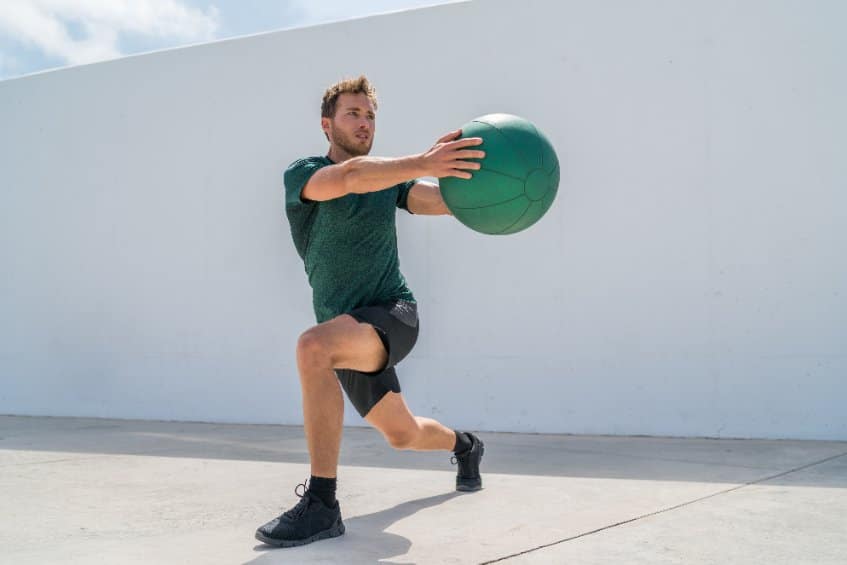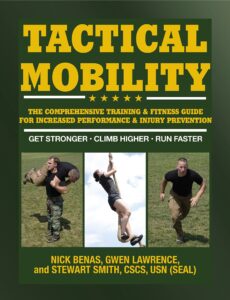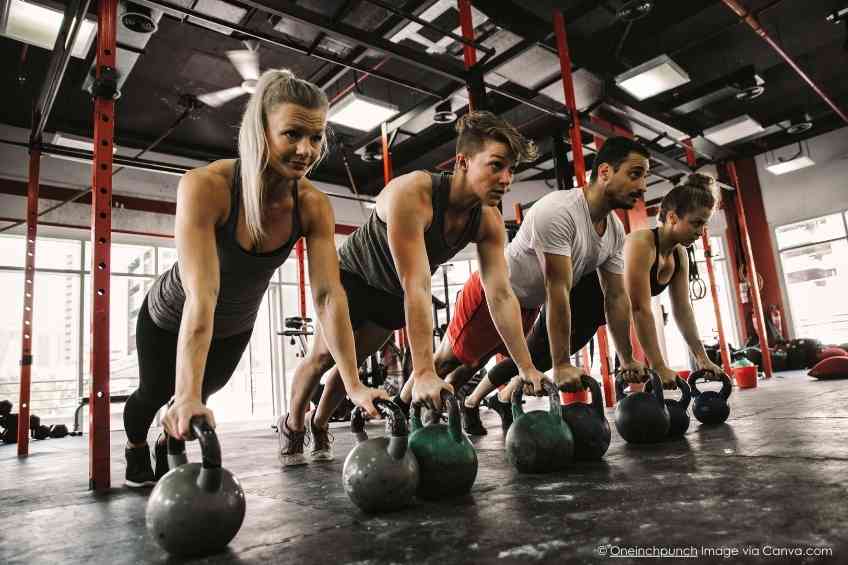Muscling up may sound like a good idea. After all, who doesn’t want a rock-hard body that bulges in all the right places? But there’s a danger in having too much of a good thing, especially if that good thing threatens to undermine general health. Gwen Lawrence came to this conclusion after a fairly circuitous personal journey that took her from a formal education in art and dance to massage therapy, sports training, a fascination with anatomy and eventually yoga. The journey not only helped establish her balance and flexibility-centric Power Yoga For Sports Training philosophy, but it also led to a collaborative effort with a former Marine and a Navy SEAL to produce a book on functional strength. The author of Tactical Mobility recently spoke with WellWell about why it’s important to stay limber and why it’s wise to keep everything in balance.
How did your personal journey and fitness philosophy come about?
I ended up going to college for art and dance, pretty intensive art, like figure drawing and things like that. But after I graduated from college, I didn’t want to be a starving artist, so I went immediately to school to become a medical massage therapist. That was definitely where my heart was and I became an anatomy junkie. I worked and picked the brains of many people that were smarter than me, which is sort of my MO in life. In the meantime, in high school, I started dating my husband and he was on a journey to become a pro baseball player, so I was watching two doubleheaders every weekend and really starting to understand the game. I was 16 years old and I sat next to all the pro scouts and picked their brains to see what they needed to do and they loved me. I had electric blue hair; they got a big kick out of me. And as time went on, I started to become a trainer in conjunction with being a massage therapist. Then my husband became a coach, his baseball career was over due to injury, which I watched as well and I started to see in my training, in massage, that some things were wrong with traditional training. So, from there, I got into being a massage therapist for the New York Giants, working with some celebrities and traveling on location with Glenn Close. She just randomly asked me, that if she sent me to school to be a yoga teacher would I be able to teach her yoga too? And I said, “All right!” So that’s kind of how my yoga journey started. Coupled with massage, the anatomy, and my sports background, it just really created this world that made me what I am.
How did you get involved with the concept of Tactical Mobility?
I was working with Bob Woodruff, the journalist, and his wife. I was part of his rehab and that sparked my journey to wanting to help the military. There are so many suicides today and they don’t have any support when they come back and my heart just broke. I was really frustrated. I started working with their foundation and teaching the veterans, which is life-changing. This is how I met one of my co-writers, Nick Benas. He’s a former marine and we were approached to write this book as a collaboration with Stewart Smith, the SEAL. For me not being in the military it was an honor to collaborate with them. But I saw that this book could not only help people in the military, but its ability to show the commitment and work ethic of those in the military could encourage others as well.
So, what is Tactical Mobility? Is it geared towards people in the military or people in service industries that need high levels of physical fitness?
I see it the other way. While it might be a little intimidating to look at because it’s army green and there are pictures of Nick inside and his routines, we want it to be accessible to everybody. I don’t even really think you have to be in top shape. It’s meant to focus on functional strength and fitness. You don’t need expensive equipment or memberships or basically anything. It’s stuff you can do in your home. You don’t even need gym clothes or anything like that. My role was to feed in my Power Yoga For Sports philosophy, which is setting the balance of the body. Not only physical balance, but it’s the symmetry of the body. I learned over decades that asymmetry leads to imbalances, which leads to injuries 100 percent of the time. So, we want to sideline those issues before they get out of control.
Strength, talking about functional strength, includes flexibility. The most powerful people that have an equal balance—and strength and flexibility are, for example, gymnasts. They just generate this amazing power and are still flexible. A lot of people sort of skip the flexibility because it’s boring or it’s hard. Then they wind up getting injuries too. But on the other side of it, the book could apply and help the military in particular with mental toughness, focus and breathing, you know, simple breathing techniques to shut down that fight or flight response and help people ease their anxieties. If it helps one person change their mind, that means the world to me. So, my aim here was to consult on the fitness part and to be the sounding board with flexibility, balance and the form in particular.
How do you define tactical mobility versus tactical fitness? What is tactical mobility?
I think of tactical mobility as that “you use it or lose it” sort of philosophy. Someone can lift and could be a powerhouse, can be just this brick wall of a person. But we’ve all seen that really big, fit, muscular people that can’t even raise their arms over their heads. So, we want this to be some kind of functional fitness program that allows every joint in the body to retain its mobility, and be healthy to keep the nervous system calm and aligned. When that happens, everything else will trickle down in terms of mental fitness and stability. I think of fitness as one thing and mobility as maintaining that range of motion in your muscles and your joints and the health that come with it.
So, it’s really about helping someone perform workouts better, not just about a specific type of workout?
Right, there are workouts but the way we designed it is to have better mobility where you’re going to have better breathing because your posture is going to be better, you’re going to have better speed, strength and power, and flexibility. It’s going to prepare you to have better muscle stamina and you’re going to learn breathing techniques.
Can this really be applied to your average duffer, someone who is at a lower fitness level than a police person, firefighter or someone in the military?
Absolutely. That’s my hope that someone might be inspired or led to the book because they see the strength and the words: “Tactical Mobility.” But then they start looking through the programming and find there are just some fun movements for the average person that they wouldn’t even begin to think of. Things like a bear crawl, inverted pole walking and crab walks. Things that are accessible but really challenge them in different ways so they can have efficient workouts.
What are the biggest misconceptions about tactical mobility? That it’s too extreme for most people?
I think they might initially think that until we start. Then they open the book and see there’s my smiling face doing some of the things. Maybe I’m wearing camo yoga leggings but I’m certainly not, you know, a marine. I think as soon as they open it, they realize it’s accessible, it’s not off-the-charts hard.
When you’re dealing with firefighters or policemen or someone like that who are involved in physical activities, what are the mistakes they’re generally making? Are they trading strength for flexibility?
They’re mixing flexibility into their routine for strength. It’s easy to understand why you would need tremendous strength and endurance when you’re a firefighter. It’s not as easy to understand the flexibility part. I’ve actually had one firefighter tell me, “Oh if I get more flexible, I’ll just shrink.” And that’s when I came up with an analogy of a bow and arrow. I tell them, “Alright, close your eyes. You have a bow and you’re holding it with your left hand and you pull that bow string back. It’s so strong, it doesn’t break but it’s so tight that you only bring it back maybe to the front of your ear, and then you let the arrow go. Basically, about 92 feet out in front of you and it hits the ground. Now we have another bow, it’s so strong that string that it doesn’t break but now it has so much flexibility that now you can bring it behind your head, really far back, now you release that arrow, where will it go? Now it has this supercharged power, it goes, it flies and it sticks into the target.” That’s exactly the same thing that you need to have with your body. You need to balance the strength with flexibility not only to increase your power, which you need in your job but for injury prevention and recovery. Then they get it.
Is there anything else to add?
Yeah, of course. I would just like to reiterate the importance of not being intimidated by the book, anybody, the whole family can join in on this.

About Gwen Lawrence
Gwen Lawrence has been a practicing fitness professional since 1990. Among other activities, she offers private yoga training, class instruction, her sport-specific Power Yoga for Sports Training program and her VYX™ (Vinyasa Yoga Extreme) system. Ms. Lawrence has also worked with several professional sports teams in the New York area as well as writing articles on fitness for Men’s Health, Women’s Health, Fitness, Shape, and Yoga Journal.
Please visit Gwenlawrence.com to learn more.
Tactical Mobility can be purchased at Amazon.













